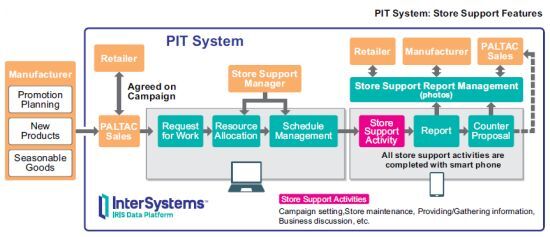
客户:PALTAC公司
挑战:采用一种系统架构,来满足数字化转型要求,以提升营收,提高效率。
结果:InterSystems IRIS数据平台成为PALTAC数字化转型的中流砥柱,并被用于开发PIT店内支持系统——这也是数字化转型的第一步
作为日本最大的化妆品、日用品和非处方药的批发商,PALTAC在将5万种商品从1,000家制造商运送到经营5万家商店的400家零售商方面发挥了不可或缺的作用。 长期以来,PALTAC一直专注于内部开发工作(占其所有信息系统的70%),以使其供应链能力具备竞争优势。
PALTAC的扩张,加上日本持续的劳动力短缺,使公司变得难以灵活移动。 PALTAC的管理计划旨在提高整个生产、分销和销售供应链的生产率,并在将产品交付给消费者的零售销售环节增加收入。
为此,PALTAC对其销售组织进行了改革,并成立了店铺支持部,该部积极参与制定促销活动,快速有效地在各个店铺推广新款、季节性的和高优先级的产品。 它还发起了一项倡议,通过与制造商和零售商合作,加速和简化整个供应链的生产力改进,该倡议以一项内部开发的应用程序为重点,该程序为PALTAC现场销售创新技术系统(PIT)。
简洁的客户体验
InterSystems IRIS®数据平台被选为PALTAC数字化转型的核心技术,而PIT应用则代表了这一转变的第一阶段。 PIT系统的开发是在基于Amazon Web Services的Linux环境中开始的。 第一阶段的开发在四个月后完成,PIT在次月上线。 从那时起,来自销售部的800名员工和来自店铺支持部的240名员工开始安装使用这一应用。
PIT 同时提供桌面应用程序和智能手机应用程序,因此 PALTAC 商店支持部门的项目负责人可以使用它来分配工作,并与现场的团队成员进行沟通。 在零售点,团队成员在他们的手机上使用PIT来分享和审查促销计划和材料,他们可以拍照、记录语音和文字笔记,以记录他们的观察和见解。 他们的报告可以通过智能手机应用程序与PIT系统同步,并在销售部和PALTAC店铺支持部的经理之间共享,以便向制造商和零售商建议额外的产品促销计划。
基于InterSystems IRIS的PIT可以实现灵活、松散耦合的系统结构,能够快速、轻松地重新配置,以响应业务环境发生的变化。 通过与关键任务系统的集成,PIT能够同步主信息,通过与信息系统的集成,PIT能够访问数据并进行分析。

PALTAC多年来一直使用InterSystems®技术,部分原因是其易于开发和维护,具备适应变化的灵活性,以及公司从InterSystems获得的出色技术支持。
PALTAC信息系统部技术开发科总经理Tetsuya Izumi表示:“InterSystems IRIS是一个功能非常丰富的数据平台,具有许多强大的功能。 例如,它内置了对REST的支持,PIT已将REST API标准化,用于在 PC 和智能手机之间进行基于屏幕的处理。 此外,我们在InterSystems技术方面拥有大量的专业知识,事实上,我们可以利用我们专业的开发能力,以及我们现有的服务和应用程序,而无需任何额外的编码,这一点非常吸引人。”

信息系统部技术开发科科长Tatsunori Iwata对此表示赞同, 他解释道:“InterSystems IRIS的特点之一是它提供的互操作性, 除了标准的API支持外,还支持常用的数据格式和适配器库,以促进InterSystems的连接,推动系统的可视化和标准化。 这种互操作性令每个人都能看到系统的状态,并在出现任何问题时立即做出反应。”
借助InterSystems IRIS,实现愿景
有了PIT,PALTAC创建一个提高整个供应链生产力和增加销售的系统的愿景已经成功实现。 在系统推出后的几个月里,“PIT使我们能够建立和统一这些活动的工作流程,并在整个销售部门共享店铺支持活动的实时信息。”PALTAC信息系统部财务信息系统科副经理Koji Kobayashi说, “由于报告数据是按日积累的,我们能够对店铺支持活动的各个方面进行分享,例如对比有无活动时的覆盖率和销售情况。 我们向客户提供信息的速度还将继续加快。”
PIT第二阶段的开发重点是使用人工智能自动分配执行店铺支持活动的员工,并为制造商和零售商提供一个具备监控商店活动和执行分析能力的门户。 未来的计划包括通过类似Uber(优步)的匹配算法将第三方合同工与零售商店匹配起来,以开展店铺支持活动。 要覆盖5万家门店——这是PALTAC的店铺支持部无法独立完成的。
与此同时,信息系统部正计划更新其基于InterSystems IRIS的系统基础设施。 一直以其先进的技术计划领军行业的PALTAC,选择了InterSystems IRIS数据平台作为实现其创新数字化转型计划的基石。





























